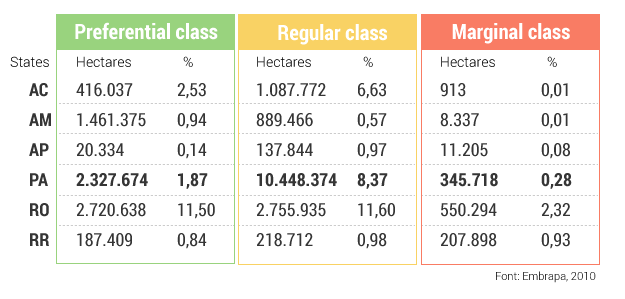In 2010, the federal government launched the Sustainable Production of Palm Oil Program in Brazil, with the goal of stimulating and disciplining the expansion of culture and developing instruments capable of guaranteeing environmentally fair and sustainable production, based on family agriculture and the preservation of the native forest.
Among the mechanisms idealized by the government to achieve its goal with the program, the Agro-ecological Zoning, Production and Management for the Culture of Palm Oil in the Amazon (ZAE) is the most important one. Regulated by the 7.172/2010 Federal Decree, the ZAE of Palm is the legal landmark that orients the production of palm in the country.
It is a technical-scientific document signed by Embrapa Soils with the participation of many researchers. It is a mandatory reading and the main reference to get to know the situation in which the production of palm in Brazil finds itself, especially in the Amazon. The analysis identifies ecological and environmental aspects that involve the planting of palm in the region.
According to the document, the expansion of the culture of palm oil in areas that have already been deforested in the Legal Amazon is recognized as an alternative for the production of oil for energetic and subsistence purposes. However, its cultivation is legally restricted in 96,3% of the Brazilian territory.
See below the table of areas available in the Legal Amazon:

The Embrapa document affirms that the use of anthropized lands – nowadays, in its majority, exhausted and occupied with pastures in an advanced state of degradation – with activities that require consolidated technologies, such as the case of the culture of palm oil, is an economical alternative that is viable to reduce the pressure of deforestation in the Amazonian biome.
According to the ZAE of palm, the forested areas in the Amazon must be avoided for the implantation of cultures, due to their important role as regulators of hydrological circles and of movement of air masses on a planetary basis.
Besides, the document states that biological diversity is still not widely known about from a scientific point of view, and should contribute in an unsuspected way with drugs of highest value for the sake of humanity.
At least 20 million hectares from the 50 million that have been already deforested in the Amazonian region are abandoned or not used to their full potential, and could be recovered with the technological innovations that are available nowadays. Among these 50 million, about 31 million of hectares are considered eligible to the planting of palm in the states of Acre, Amazonas, Amapá, Maranhão, Mato Grosso, Pará, Rondônia and Roraima. However, palm takes up about 178 thousand hectares presently.
